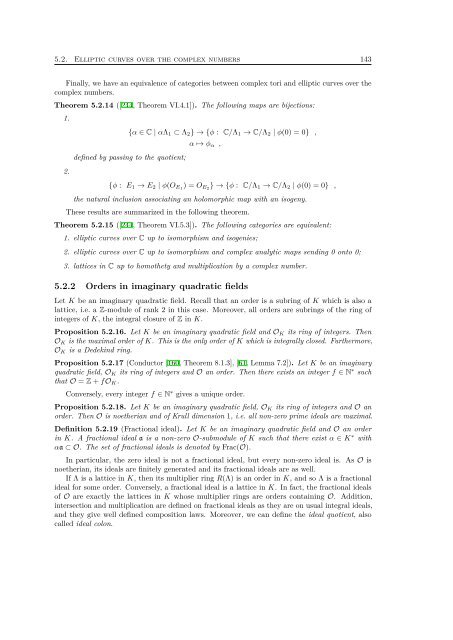here - Sites personnels de TELECOM ParisTech - Télécom ParisTech
here - Sites personnels de TELECOM ParisTech - Télécom ParisTech
here - Sites personnels de TELECOM ParisTech - Télécom ParisTech
Create successful ePaper yourself
Turn your PDF publications into a flip-book with our unique Google optimized e-Paper software.
5.2. Elliptic curves over the complex numbers 143Finally, we have an equivalence of categories between complex tori and elliptic curves over thecomplex numbers.Theorem 5.2.14 ([244, Theorem VI.4.1]). The following maps are bijections:1.2.{α ∈ C | αΛ 1 ⊂ Λ 2 } → {φ : C/Λ 1 → C/Λ 2 | φ(0) = 0} ,<strong>de</strong>fined by passing to the quotient;α ↦→ φ α ,{φ : E 1 → E 2 | φ(O E1 ) = O E2 } → {φ : C/Λ 1 → C/Λ 2 | φ(0) = 0} ,the natural inclusion associating an holomorphic map with an isogeny.These results are summarized in the following theorem.Theorem 5.2.15 ([244, Theorem VI.5.3]). The following categories are equivalent:1. elliptic curves over C up to isomorphism and isogenies;2. elliptic curves over C up to isomorphism and complex analytic maps sending 0 onto 0;3. lattices in C up to homothety and multiplication by a complex number.5.2.2 Or<strong>de</strong>rs in imaginary quadratic fieldsLet K be an imaginary quadratic field. Recall that an or<strong>de</strong>r is a subring of K which is also alattice, i.e. a Z-module of rank 2 in this case. Moreover, all or<strong>de</strong>rs are subrings of the ring ofintegers of K, the integral closure of Z in K.Proposition 5.2.16. Let K be an imaginary quadratic field and O K its ring of integers. ThenO K is the maximal or<strong>de</strong>r of K. This is the only or<strong>de</strong>r of K which is integrally closed. Furthermore,O K is a De<strong>de</strong>kind ring.Proposition 5.2.17 (Conductor [160, Theorem 8.1.3], [61, Lemma 7.2]). Let K be an imaginaryquadratic field, O K its ring of integers and O an or<strong>de</strong>r. Then t<strong>here</strong> exists an integer f ∈ N ∗ suchthat O = Z + fO K .Conversely, every integer f ∈ N ∗ gives a unique or<strong>de</strong>r.Proposition 5.2.18. Let K be an imaginary quadratic field, O K its ring of integers and O anor<strong>de</strong>r. Then O is noetherian and of Krull dimension 1, i.e. all non-zero prime i<strong>de</strong>als are maximal.Definition 5.2.19 (Fractional i<strong>de</strong>al). Let K be an imaginary quadratic field and O an or<strong>de</strong>rin K. A fractional i<strong>de</strong>al a is a non-zero O-submodule of K such that t<strong>here</strong> exist α ∈ K ∗ withαa ⊂ O. The set of fractional i<strong>de</strong>als is <strong>de</strong>noted by Frac(O).In particular, the zero i<strong>de</strong>al is not a fractional i<strong>de</strong>al, but every non-zero i<strong>de</strong>al is. As O isnoetherian, its i<strong>de</strong>als are finitely generated and its fractional i<strong>de</strong>als are as well.If Λ is a lattice in K, then its multiplier ring R(Λ) is an or<strong>de</strong>r in K, and so Λ is a fractionali<strong>de</strong>al for some or<strong>de</strong>r. Conversely, a fractional i<strong>de</strong>al is a lattice in K. In fact, the fractional i<strong>de</strong>alsof O are exactly the lattices in K whose multiplier rings are or<strong>de</strong>rs containing O. Addition,intersection and multiplication are <strong>de</strong>fined on fractional i<strong>de</strong>als as they are on usual integral i<strong>de</strong>als,and they give well <strong>de</strong>fined composition laws. Moreover, we can <strong>de</strong>fine the i<strong>de</strong>al quotient, alsocalled i<strong>de</strong>al colon.
















